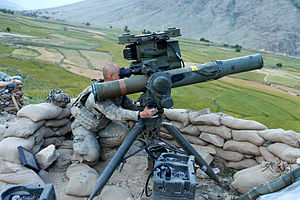BGM-71 TOW
| BGM-71 TOW | |
|---|---|

A tripod-mounted TOW unit of the U.S. Army in Kunar Province, Afghanistan in May 2009.
|
|
| Type | Anti-tank missile |
| Place of origin | United States |
| Service history | |
| In service | 1970–present |
| Used by | See Operators |
| Production history | |
| Designer | Hughes Aircraft Company |
| Designed | 1963–1968 |
| Unit cost | £8,500 (1984) |
| Specifications | |
| Length | 1.16–1.17 m (probe folded) 1.41–1.51 m (probe extended) |
| Diameter | 152mm |
|
|
|
| Warhead weight | 3.9–6.14 kg |
|
|
|
| Wingspan | 0.46 m |
|
Operational
range |
up to 4,200 m |
| Speed | 278–320 m/s |
|
Guidance
system |
Optically tracked, Wire-guided missile |
The BGM-71 TOW ("Tube-launched, Optically tracked, Wire-guided") is an American anti-tank missile. TOW replaced much smaller missiles like the SS.10 and ENTAC, offering roughly twice the effective range, a more powerful warhead, and a greatly improved semi-automatic guidance system that could also be equipped with infrared cameras for night time use.
First produced in 1970, the TOW is one of the most widely used anti-tank guided missiles. It can be found in a wide variety of manually carried and vehicle mounted forms, as well as widespread use on helicopters. Originally designed by Hughes Aircraft in the 1960s, the weapon is currently produced by Raytheon.
Initially developed by Hughes Aircraft between 1963 and 1968, the XBGM-71A was designed for both ground and heli-borne applications. In 1997, Raytheon Co. purchased Hughes Electronics from General Motors Corporation, so development and production of TOW systems now comes under the Raytheon brand. The weapon is used in anti-armor, anti-bunker, anti-fortification and anti-amphibious landing roles. The TOW is in service with over 45 militaries and is integrated on over 15,000 ground, vehicle and helicopter platforms worldwide.
In its basic infantry form, the system comprises a missile in a sealed tube which is clipped to a launch tube prior to use. When required, the missile tube is attached to the rear of the launch tube, the target sighted and the missile fired. The launch motor (also called "kick" motor or booster) ejects the missile from the launch tube, at which point four wings indexed at 45 degrees just forward of the booster nozzles spring open forwards, four tail control surfaces flip open rearwards, and sustained propulsion is subsequently provided by the flight motor (sustainer) which fires through lateral nozzles amidships and propels the missile to the target. An optical sensor on the sight continuously monitors the position of a light source on the missile relative to the line-of-sight, and then corrects the trajectory of the missile by generating electrical signals that are passed down two wires to command the control surface actuators. After launch, the operator simply has to keep the cross-hairs of his sight pointing at the target, and the guidance system will automatically transmit corrective commands to the missile through the wire.
...
Wikipedia
